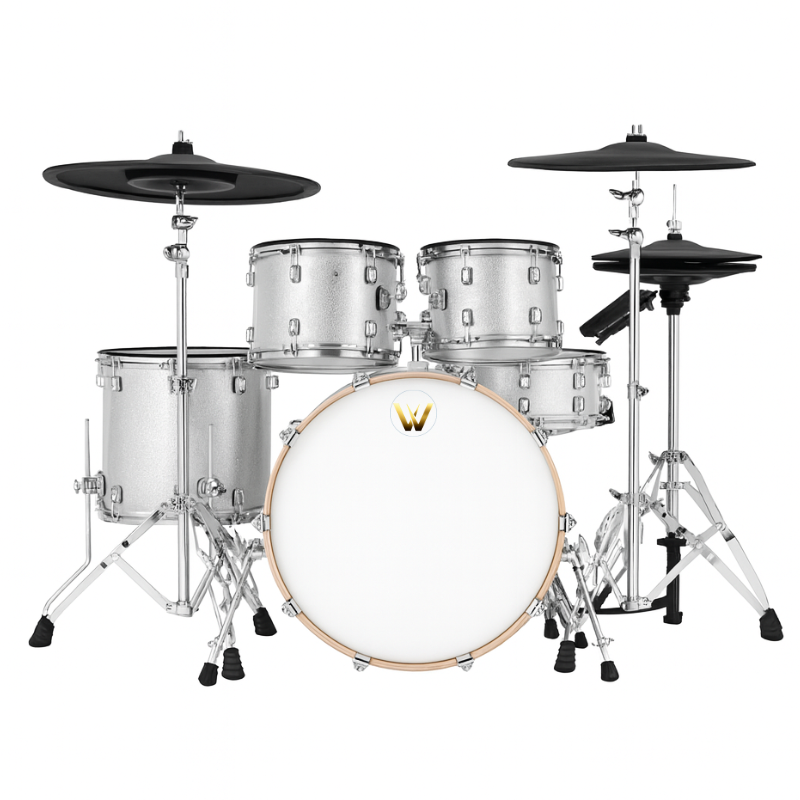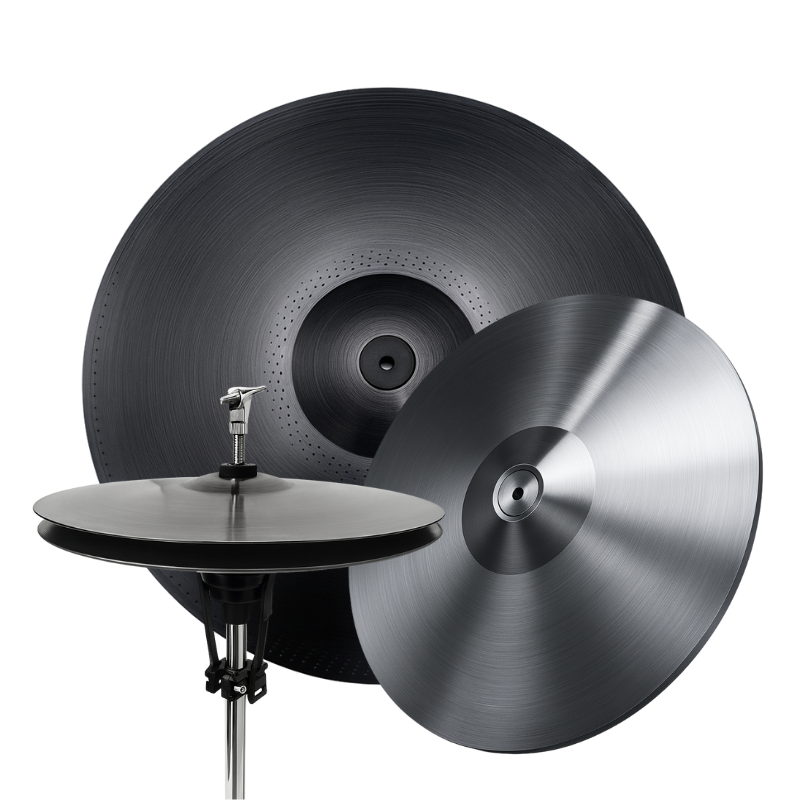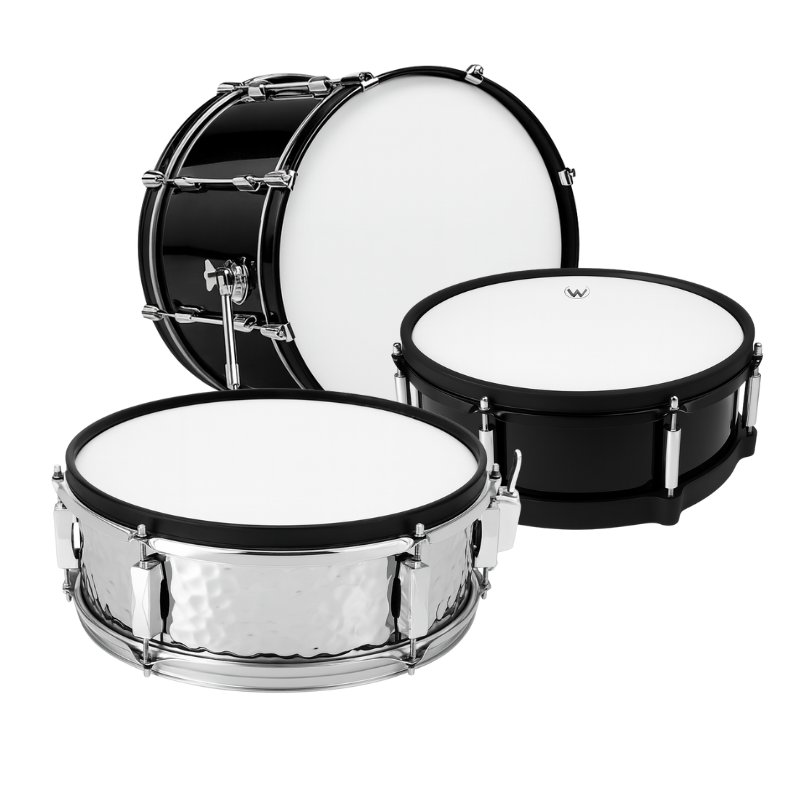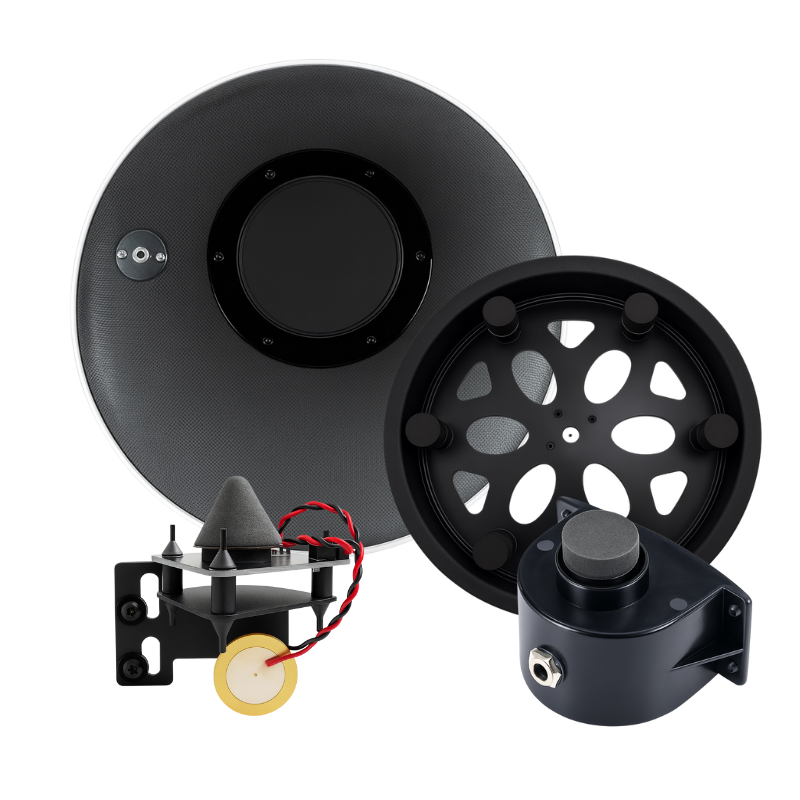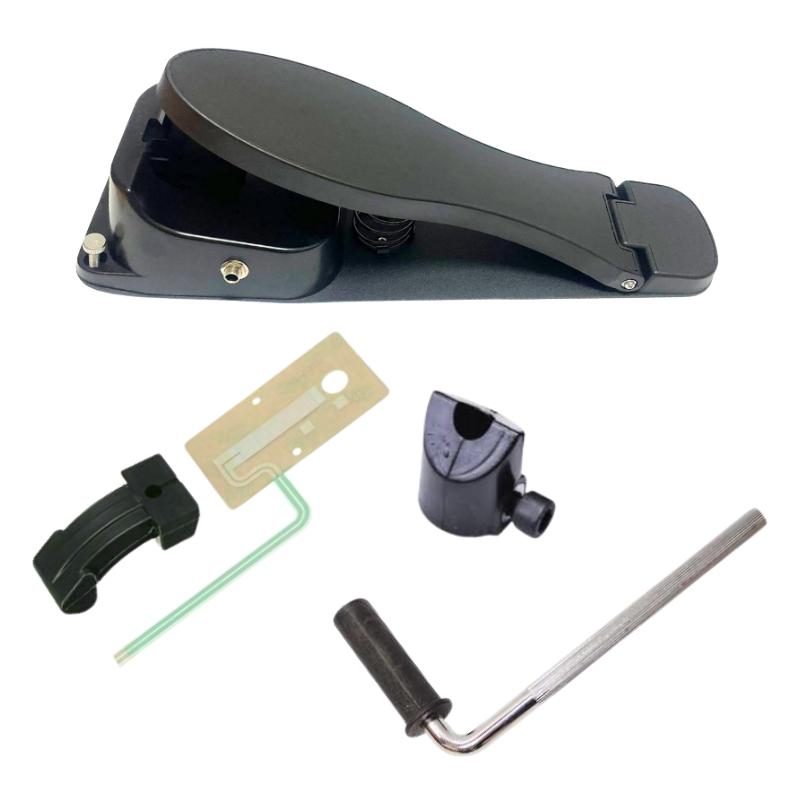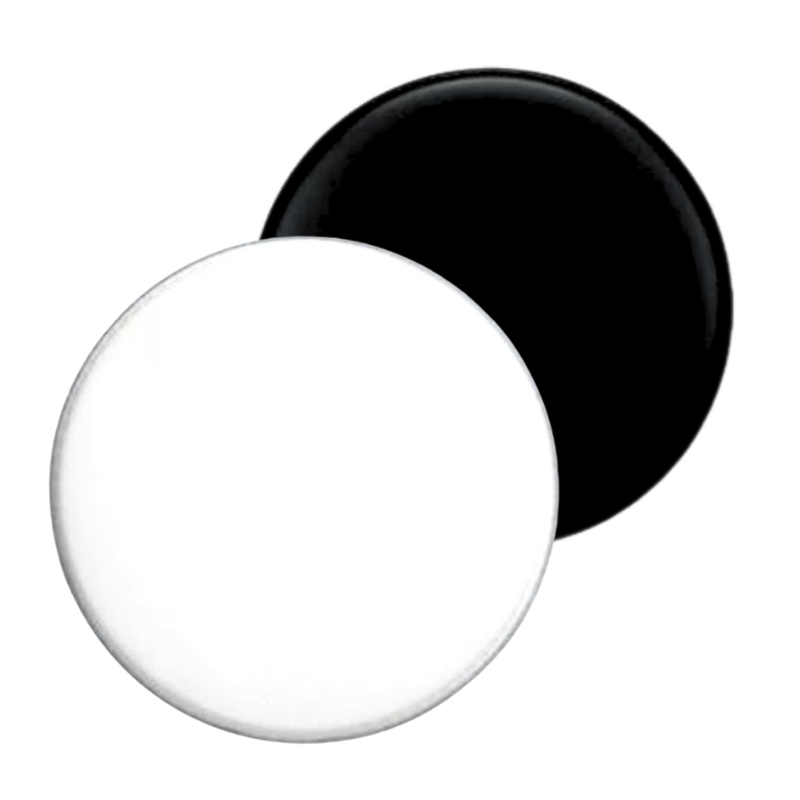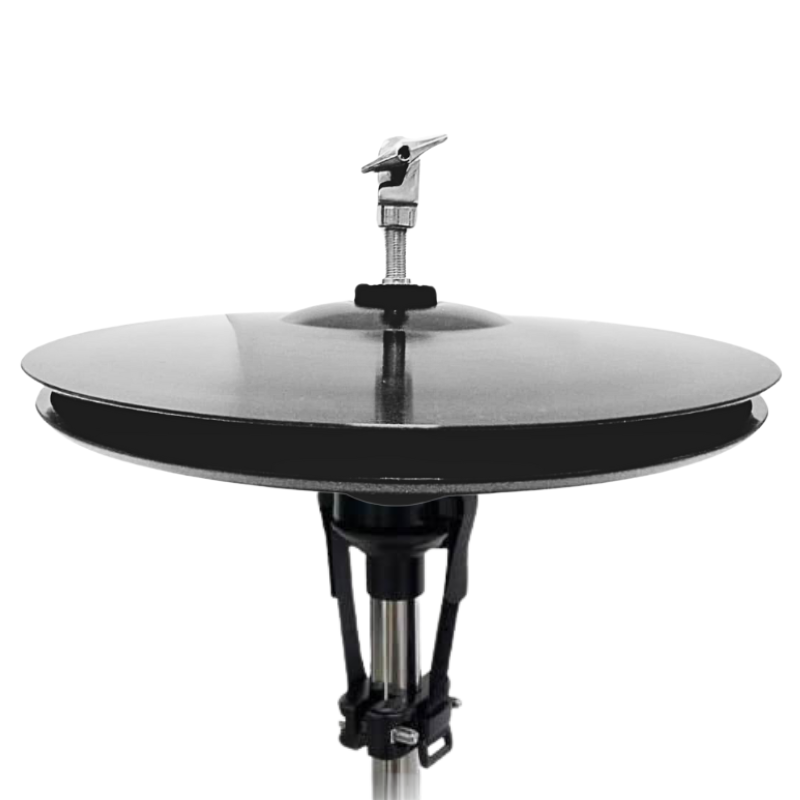
Le guide complet des options de charleston électronique : alternatives Roland et au-delà
Partager
Les batteurs électroniques sont plus exigeants que jamais concernant la sensation, l'articulation et le suivi du hi-hat.
C’est le cymbale la plus expressive du kit, et celle qui fait ou défait le réalisme dans une configuration e-drum. Si vous cherchez une alternative Roland hi-hat ou un moyen d'améliorer un kit Alesis ou Yamaha, cet article explique la technologie en langage clair, ce qu'il faut rechercher, et comment choisir le bon electronic hi-hat pour votre module.
Nous vous indiquerons également des solutions éprouvées deux pièces de 12 pouces que vous pouvez intégrer à votre kit dès aujourd'hui.
Comment fonctionnent les electronic hi-hats : capteurs, contrôleurs et MIDI
Au cœur, un electronic hi-hat se compose de deux parties : la surface de frappe qui détecte les coups (zones bord et voûte pour un dual-zone hi-hat) et un contrôleur qui indique à quel point les cymbales sont ouvertes ou fermées.
Votre module traduit cette position du contrôleur en MIDI CC #4 (le message « hi-hat controller ») et mélange des échantillons ou des modèles pour produire les articulations chick, foot splash, fermé serré, semi-ouvert et complètement ouvert. Plus la résolution du contrôleur et le suivi de vélocité du pad sont précis, plus vos grooves paraissent réalistes.
Il existe plusieurs types de contrôleurs sur le marché. Les résistances variables traditionnelles sont courantes et compatibles avec de nombreux modules Roland TD et cerveaux Alesis, tandis que certaines marques utilisent des capteurs optiques ou magnétiques pour améliorer la durabilité et la fluidité. Quand vous lisez « continu » ou « variable hi-hat », c’est ce qui permet des transitions fines d’ouverture/fermeture plutôt que seulement deux ou trois positions fixes.
Pourquoi de nombreux batteurs cherchent au-delà des hi-hats assortis à la marque
Le matériel assorti à la marque est pratique, mais peut être coûteux, et tous les chapeaux OEM ne donnent pas la même sensation sous la baguette. Les joueurs recherchent souvent une alternative Roland hi-hat ou une meilleure option pour les modules Alesis Command, Crimson, Surge, Nitro ou Yamaha DTX afin d’obtenir un design deux pièces plus réactif, un diamètre plus grand, ou une surface qui rebondit comme un vrai cymbale. Un diamètre de 12 pouces est un compromis idéal : assez grand pour un placement précis des baguettes, assez petit pour se monter confortablement sur un rack compact.
Si vous construisez une voie de mise à niveau, commencez par le hi-hat. C’est le changement le plus visible par euro dépensé et peut transformer les ghost notes, foot splashes et motifs chick serrés dans les styles funk, pop et worship contemporain.
Bases de compatibilité pour Roland, Alesis, Yamaha et autres
Les modules Roland comme TD-17, TD-27 et TD-50 attendent généralement un contrôleur continu et un pad dual-zone pour la voûte et le bord. Les modules Alesis varient selon le modèle ; le milieu de gamme et plus supportent en général le contrôle variable du hi-hat, tandis que les modèles d'entrée peuvent nécessiter une routine de calibration spécifique. Les cerveaux Yamaha DTX inversent parfois la polarité ou attendent une pente différente, que vous réglerez lors de la calibration. Vérifiez toujours l’étiquette d’entrée hi-hat de votre module et le manuel pour des termes comme « VH », « variable », « continuous » ou « HH CTRL ».
Pour simplifier le processus, nous avons rassemblé des idées pratiques de mise à niveau et des conseils de câblage dans notre ressource de construction : Build the perfect upgrade for your e-drum kit. Pour un aperçu rapide des pads cymbales compatibles, explorez notre collection : Electronic cymbals.
Options recommandées de hi-hat deux pièces de 12 pouces
Si vous voulez la réponse et le rebond les plus acoustiques, choisissez un two-piece hi-hat qui se monte sur un pied de hi-hat standard. Le mouvement des plaques supérieure/inférieure donne à votre pied le même micro-contrôle que vous utilisez sur des chapeaux acoustiques, et les données continues du contrôleur traduisent cette nuance au module.
Pour les joueurs qui préfèrent une surface silencieuse et réaliste avec une détection détaillée bord/voûte, le Phantom 12-Inch Silicone 2-Piece Hi-Hat est un choix solide, testé en concert. Il est conçu pour une articulation open/close expressive, une définition chick nette et un rebond contrôlé, idéal pour les modules Roland TD-17/27/50 et avancés Alesis avec contrôle variable. Voir détails et disponibilité ici : Phantom 12-inch Silicone 2-Piece Hi-Hat.
Si vous préférez une sensation de jeu classique avec une définition nette des baguettes et un contraste musical voûte-bord, le Black Knight 12-Inch 2-Piece Hi-Hat offre une réponse équilibrée qui s’intègre bien dans les grooves rock, fusion et R&B moderne. C’est une solution dual-zone hi-hat fiable qui s’intègre bien aux modules populaires et offre une calibration prévisible. En savoir plus ici : Black Knight 12-inch 2-Piece Hi-Hat.
Vous cherchez notre dernier design avec un réglage affiné des capteurs et une pente de contrôleur fluide ? Le Phantom EVO 12-Inch Dual-Piece Electronic Hi-Hat pousse le réalisme plus loin avec des courbes MIDI CC constantes et une sensation stable de style acoustique sur votre pied. C’est une excellente alternative Roland hi-hat qui s’associe aussi bien avec les modules Alesis et Yamaha de milieu à haut de gamme supportant le contrôle continu. Découvrez-le ici : Phantom EVO 12-inch Dual-Piece Electronic Hi-Hat.
Conseils d'installation et de calibration pour un meilleur suivi
Avant de jouer, réglez mécaniquement votre hi-hat comme vous le feriez sur un kit acoustique. Ajustez la hauteur du clutch pour que la plaque supérieure soit confortable pour les foot chicks et splashes, puis verrouillez-la. Sur le module, lancez la routine de calibration hi-hat. La plupart des cerveaux vous guident à travers les positions complètement fermée, mi-ouverte et complètement ouverte pour cartographier la plage du contrôleur sur le MIDI CC #4. Après calibration, testez quelques motifs à différentes ouvertures pour confirmer que la courbe semble naturelle. Si les chapeaux passent trop vite de fermé à semi-ouvert, augmentez la plage d’ouverture ou ajustez la courbe pour que le premier tiers de votre course de pédale reste serré pour des 16èmes précis.
Le gain est important pour des dynamiques propres. Réglez la sensibilité du pad pour que les ghost notes soient détectées sans tout rendre « chaud ». Pour les chapeaux dual-zone, équilibrez le seuil voûte et bord pour ne pas déclencher accidentellement les sons de bord en jouant sur la voûte. Enfin, assignez vos échantillons ou modèles hi-hat préférés et ajustez le niveau de foot splash pour qu’il ressorte sans écraser le groove.
Choisir le bon hi-hat pour votre genre et module
Les batteurs rock et pop valorisent généralement un bord ferme et articulé pour les motifs entraînants et les chicks serrés ; un deux pièces de 12 pouces avec une réponse stable du contrôleur offre cette autorité. Les joueurs funk et fusion veulent souvent des positions mi-ouvertes nuancées et des rebonds rapides pour les 16èmes ghostés ; cherchez un hi-hat avec des courbes CC fluides et un suivi voûte constant. Si vous vous entraînez dans des espaces partagés, une surface silicone peut réduire le bruit acoustique tout en gardant une sensation de baguette crédible.
Du côté des modules, les cerveaux Roland TD offrent généralement les transitions positionnelles les plus riches lorsqu’ils reçoivent un contrôleur continu et stable. Les utilisateurs Alesis doivent confirmer que leur modèle supporte le contrôle variable du hi-hat puis passer quelques minutes en calibration pour perfectionner la détection pied-fermé et splash. Les propriétaires Yamaha DTX peuvent avoir besoin d’inverser la polarité ou d’ajuster la courbe d’entrée ; le résultat final peut toujours être excellent avec un contrôleur deux pièces approprié.
Quelle suite donner
Si vous planifiez un rafraîchissement complet de votre kit ou simplement le remplacement d’un pad vieillissant, commencez par les chapeaux. Ils changent la sensation de tout votre kit plus que n’importe quel autre cymbale. Parcourez notre sélection triée sur le volet de electronic cymbals et hi-hats ici : Electronic cymbals collection. Pour un chemin étape par étape pour mixer les marques et assortir les contrôleurs aux modules, mettez en favori notre hub de mise à niveau : Build the perfect upgrade for your e-drum kit. Vous voulez voir des clips et astuces en situation réelle ? Suivez-nous sur Instagram : @worldrummersofficial.
Quand vous serez prêt, choisissez le hi-hat deux pièces de 12 pouces qui correspond à votre style - que ce soit le Phantom pour une sensation silicone à faible bruit, le Black Knight pour une définition nette, ou le Phantom EVO pour le dernier réglage des capteurs - et donnez à votre module le contrôle continu qu’il mérite. Vos grooves vous remercieront.

